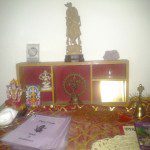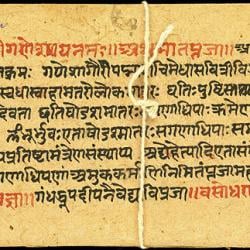We are doing a scripture study together: reading along through some scriptures and discussing the passages. Today we are starting the Kena Upanishad. The previous scripture was the Isha Upanishad (find all Scripture posts here)
Here are a few different translations of the first section of the Kena Upanishad…
1)
Chapter I
1
The disciple asked: Om. By whose will directed does the mind proceed to its object? At whose command does the prana, the foremost, do its duty? At whose will do men utter speech? Who is the god that directs the eyes and ears?
2
The teacher replied: It is the Ear of the ear, the Mind of the mind, the Speech of speech, the Life of life, and the Eye of the eye. Having detached the Self [from the sense-organs] and renounced the world, the wise attain to Immortality.
3-4
The eye does not go thither, nor speech, nor the mind. We do not know It; we do not understand how anyone can teach It. It is different from the known; It is above the unknown. Thus we have heard from the preceptors of old who taught It to us.
5
That which cannot be expressed by speech, but by which speech is expressed—That alone know as Brahman, and not that which people here worship.
6
That which cannot be apprehended by the mind, but by which, they say, the mind is apprehended—That alone know as Brahman, and not that which people here worship.
7
That which cannot be perceived by the eye, but by which the eye is perceived—That alone know as Brahman, and not that which people here worship.
8
That which cannot be heard by the ear, but by which the hearing is perceived—That alone know as Brahman, and not that which people here worship.
9
That which cannot be smelt by the breath, but by which the breath smells an object—That alone know as Brahman, and not that which people here worship.
2)
Chapter I
1 The disciple asked: Om. By whose will directed does the mind proceed to its object? At whose command does the prana, the foremost, do its duty? At whose will do men utter speech? Who is the god that directs the eyes and ears?
2 The teacher replied: It is the Ear of the ear, the Mind of the mind, the Speech of speech, the Life of life and the Eye of the eye. Having detached the Self from the sense—organs and renounced the world, the Wise attain to Immortality.
3—4 The eye does not go thither, nor speech, nor the mind. We do not know It; we do not understand how anyone can teach It. It is different from the known; It is above the unknown. Thus we have heard from the preceptors of old who taught It to us.
5 That which cannot be expressed by speech, but by which speech is expressed—That alone know as Brahman and not that which people here worship.
6 That which cannot be apprehended by the mind, but by which, they say, the mind is apprehended—That alone know as Brahman and not that which people here worship.
7 That which cannot be perceived by the eye, but by which the eye is perceived—That alone know as Brahman and not that which people here worship.
8 That which cannot he heard by the ear, but by which the hearing is perceived—That alone know as Brahman and not that which people here worship.
9 That which cannot be smelt by the breath, but by which the breath smells an object—That alone know as Brahman and not that which people here worship.
–http://www.bharatadesam.com/spiritual/upanishads/kena_upanishad.php
3)
ॐ केनेषितं पतति प्रेषितं मनः
केन प्राणः प्रथमः प्रैति युक्तः .
केनेषितां वाचमिमां वदन्ति
चक्षुः श्रोत्रं क उ देवो युनक्ति || 1 ||THE Pupil asks: ‘At whose wish does the mind sent forth proceed on its errand? At whose command does the first breath go forth? At whose wish do we utter this speech? What god directs the eye, or the ear?’
श्रोत्रस्य श्रोत्रं मनसो मनो यद्
वाचो ह वाचं स उ प्राणस्य प्राणः .
चक्षुषश्चक्षुरतिमुच्य धीराः
प्रेत्यास्माल्लोकादमृता भवन्ति || 2 ||The Teacher replies: ‘It is the ear of the ear, the mind of the mind, the speech of speech, the breath of breath, and the eye of the eye. When freed (from the senses) the wise, on departing from this world, become immortal
न तत्र चक्षुर्गच्छति न वाग्गच्छति नो मनः .
न विद्मो न विजानीमो यथैतदनुशिष्यात || 3 ||The eye does not go thither, nor speech, nor mind. We do not know, we do not understand, how any one can teach it
अन्यदेव तद्विदितादथो अविदितादधि
इति शुश्रुम पूर्वेषां ये नस्तद्व्याचचक्षिरे || 4 ||It is different from the known, it is also above the unknown, thus we have heard from those of old, who taught us this
यद्वाचाऽनभ्युदितं येन वागभ्युद्यते .
तदेव ब्रह्म त्वं विद्धि नेदं यदिदमुपासते || 5 ||That which is not expressed by speech and by which speech is expressed, that alone know as Brahman, not that which people here adore
यन्मनसा न मनुते येनाहुर्मनो मतम
तदेव ब्रह्म त्वं विद्धि नेदं यदिदमुपासते || 6 ||That which does not think by mind, and by which, they say, mind is thought, that alone know as Brahman, not that which people here adore
यच्चक्षुषा न पश्यति येन चक्षूँषि पश्यति
तदेव ब्रह्म त्वं विद्धि नेदं यदिदमुपासते || 7 ||That which does not see by the eye, and by which one sees (the work of) the eyes, that alone know as Brahman, not that which people here adore
यच्छ्रोत्रेण न शृणोति येन श्रोत्रमिदं श्रुतम
तदेव ब्रह्म त्वं विद्धि नेदं यदिदमुपासते || 8 ||That which does not hear by the ear, and by which the ear is heard, that alone know as Brahman, not that which people here adore.
यत्प्राणेन न प्राणिति येन प्राणः प्रणीयते
तदेव ब्रह्म त्वं विद्धि नेदं यदिदमुपासते || 9 ||That which does not breathe by breath, and by which breath is drawn, that alone know as Brahman, not that which people here adore
इति केनोपनिषदि प्रथमः खण्डःThus ends the first chapter of Kena Upanishad– See more at: http://www.aagama.in/content/kena-upanishad-chapter-1
When the beginning questions are translated with the word “mind” the commenter at Baps.org points out that the Sanskrit concept of the mind is more complex than the English. The mind here comprises all four parts: mana, buddhi, chitt and ahamkãr (roughly: thinking part, discerning part, heart/feeling part, ego/attachment part).
The translations that include the word “Prana” means “breath” in the sense of the air that means we are alive and that moves through us and allows us to move.
The commentary goes on to say that while we as human beings and other living creatures need “tools such as our eyes, ears and mind in order to see, hear and think; we need breath to breathe; we cannot see, hear, think or live without these; but this does not apply to Paramãtmã (God). His energy is not dependent on anything.”
Also, “his (God’s) reservoir of energy can never be exhausted. No matter how much you give from infinity, infinity remains infinity.”
To believe that we are the do-ers and the causers is to be “like a dog that walks under a cart thinking that it is he who is moving it.”
***
“One of the shortest of the Upanishads, the Kena is also sometimes known as the Talavakra Upanishad. ” –http://everything2.com/title/Kena+Upanishad
“The Kena deals with the knowledge of Brahman, and delivers a summary of the great lesson given in other Upanishads, namely, neti, neti: Brahman is not this, not that; Brahman is not any of the things you can say or think or perceive. Also, and importantly, Brahman is self-existing, not imaginary, and not to be attained by mere human effort and decision…Both the first section, in the form of a dialogue between master and pupil, and the second section, in the form of a fable about a contest between the gods, emphasize the fact that Brahman, not the individual human being or god, is the true actor, knower, thinker and perceiver. In other words, ‘I’ cannot know Brahman, because Brahman is, itself, the Knower.” –http://everything2.com/title/Kena+Upanishad
My Take
This is a really philosophical text, asking some very intriguing questions. At some point anyone who is paying attention begins to wonder, how does my mind think? How do my eyes see? What energy causes this system of my body and the world to function? God is that energy, according to Kena Upanishad. Brahma is the method by which the world can be perceived.
The “breath of the breath” and the like makes me think of the Plato ideal of an object. Brahma is the breath, but also the ideal of breath, the very definition of what breath is.
What is the Kena Upanishad? There are hundreds of Upanishads, but ten are considered principle texts, the most important ones. These were written approximately 1000 years BCE. The word translates to “by whom,” which refers to the opening question of the text.
केन प्राणः प्रथमः प्रैति युक्तः .
केनेषितां वाचमिमां वदन्ति
चक्षुः श्रोत्रं क उ देवो युनक्ति || 1 |
चक्षुषश्चक्षुरतिमुच्य धीराः
प्रेत्यास्माल्लोकादमृता भवन्ति || 2 |
तदेव ब्रह्म त्वं विद्धि नेदं यदिदमुपासते || 5 ||
तदेव ब्रह्म त्वं विद्धि नेदं यदिदमुपासते || 6 ||
तदेव ब्रह्म त्वं विद्धि नेदं यदिदमुपासते || 7 ||
तदेव ब्रह्म त्वं विद्धि नेदं यदिदमुपासते || 9 ||
– See more at: http://www.aagama.in/content/kena-upanishad-chapter-1















